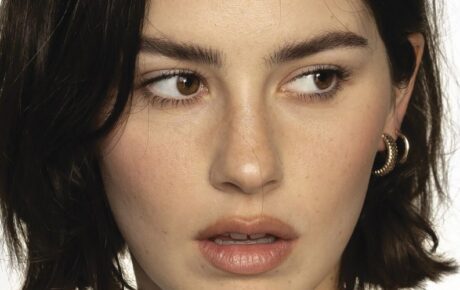“My artpop could mean anything”, Lady Gaga declared to the world on her bombastic third studio album ARTPOP, now miraculously celebrating its tenth anniversary. It’s a statement of a title, one that carries the weight of a polarised critical reception, modern cult classic status, and a turbulent emotional era for Gaga herself. Regardless of its reception, from the opening moments of ARTPOP’s tremendous lead single ‘Applause’, this is an album which indeed stands to “crash the critics saying ‘is it right or is it wrong?’”.
Brought into the world on November 6th, 2013, ARTPOP is an aesthetic meld of the sex and glamour of celebrity to the historical drama of fine art. Designed by Jeff Koons, its album cover depicts a statuesque, nude Gaga posing with Koons’ famed gazing ball, in front of Boticelli’s ‘The birth of Venus’. This visual explosion reflects the album’s deceptively controlled sonic, lyrical and thematic chaos.
At first glance, many wrote off ARTPOP as riding the then-tired wave of electronic dance music. But diving fully into the record reveals a far more innovative maximalist sound. ARTPOP did not opt for the genre’s traditionally simple, catchy hooks. Even the slick choruses of songs like ‘G.U.Y’ and ‘Do What You Want’ opt for more melodrama than their peers, packing bright, bizarre lyrics and complex double meanings into bouncy pop rhythms. Classic dancefloor drops are made bewildering by unexpected instrumental elements, like the mariachi twist of western guitar on ‘Aura’, or the trap-hop of ‘Jewels ‘N’ Drugs’ tucking orchestral flourishes beneath its screaming synths. Furthermore, Gaga experiments with her vocal more than ever, from raw squeals and whines on ‘Swine’ to deadpan Valley girl on ‘Donatella’. Accompanied by a star-studded production team including DJ White Shadow, will.i.am, David Guetta and Zedd, Gaga balanced ARTPOP’s commercial intent with her deeply unique sense of artistry, lending inspiration to the hyperpop movement of the late 2010s.
As if Stefani Germanotta’s Lady Gaga identity wasn’t already enough, she also stepped into pop star tradition with multiple alter-egos across ARTPOP. Transforming Renaissance figure Venus into a modern-day pop star cleverly nods to both Gaga and Venus’s roles in creating pop culture controversy. Venus became the first secular painting to incorporate nudity, whilst Gaga’s obscene fashion and performance art consistently generated public criticism leading up to ARTPOP. Outside of portraying Venus, Gaga also worked through her reliance on marijuana following her Born This Way tour hip injury by stepping into her fictional brunette self Mary Jane Holland. Mary Jane is a confident woman who refuses to “be a slave to the blonde, or the culture of the popular”, until the high runs out on Dope, a vulnerable ballad revealing the true cost of Gaga’s addiction.
By this point a certified gay icon, Gaga also paid attention on ARTPOP to the themes which resonated with her queer audience. Campy spoken-word introductions litter the album. On ‘G.U.Y’, she greets her listeners like an alien descending to earth, whilst ‘Donatella’ sees Gaga coyly shrug off her problems with the reminder that “I’m blonde, I’m skinny, I’m rich, and I’m a little bit of a bitch”. This confidence and power play is a prominent thread across the record. ARTPOP is frequently fascinated with flipping the script of gendered dynamics. Gaga pays tribute to her drag persona Joe Calderone, stepping into the conventionally assumed man’s role on several tracks. Her position in charge is made indisputable by tongue-in-cheek self-referential lyrics noting her impressive career, particularly on ‘Gypsy’, where she reminds us she’s still “married to the night” (‘Marry the Night’) and “I don’t speak German, but I try” (‘Scheiße’).
Of course, ARTPOP is best understood within the social context of its release. The project faced a troubled rollout from the get-go. Lead single ‘Applause’ leaked weeks before its intended release, forcing an early drop that pitted it against Katy Perry’s ‘Roar’ in an infamous chart battle which inspired an episode of Glee. During the album’s creation and promotion, Gaga also suffered through extensive personal trauma, experiencing PTSD from sexual assault, the pain of a recent fibromyalgia diagnosis, and the drama of losing her professional team, including her long-term manager. On top of this, the general public seemed to grow tired of Gaga’s highly publicised wild behaviour. Gaga pioneered the world’s first flying dress, played into the rumoured relationship between Marilyn Monroe and JFK on late night television, pursued an ill-fated live show in space, and even hired a performance artist to vomit on her on the stage of Austin music festival South by Southwest. All of these antics in 2013 alone had mainstream listeners exhausted by ARTPOP’s November debut, leaving them disinterested in giving it the intentional listen it deserved.
This complex situation also led to the infamous scrapping of the sequel album, ARTPOP ACT II. Through live performances and material shared through the now defunct ARTPOP app, Gaga confirmed extensive additional material for a follow-up that never came. This would have theoretically included collaborations with Azaelia Banks and Kendrick Lamar, as well as a multitude of exciting experimental tracks which leaked online in various stages of completion. Thus, for the past ten years, fans have been fiending for more, adding to the mystique and wonder surrounding the ARTPOP era. With Gaga Tweeting in 2019 that she “doesn’t remember ARTPOP” to begin with, it seems a sequel is nothing but a pipe dream, but with the original album being this impressive, it’s hard to blame Little Monsters for holding out hope.
One thing’s for sure: beneath the roaring experimental sound of ARTPOP and its frequently comical language, there’s a deep hurt and sense of raw, genuine emotion from the woman behind Lady Gaga. It’s at her most theatrical that we see Stefani Germanotta at her most personal. “Culture loves to build and give birth to fantasies and then destroy them”, Gaga told Access Hollywood in 2012, a statement that summarises the sweeping highs and crushing lows of ARTPOP. Love it or hate it, this is a record with far more to say than first listen would suggest, and as promised, it exists on the line of where high art and lowbrow pop music collide. A decade on, Lady Gaga still “lives for the applause”. Giving that applause up on ARTPOP’s tenth anniversary is undeniably long overdue.












